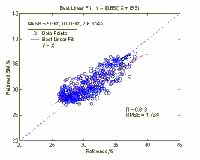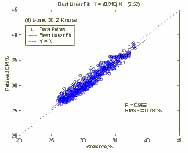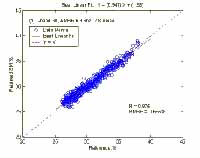| GISdevelopment.net ---> AARS ---> ACRS 2000 ---> Agriculture |
On The Retrievals Of Surface
Soil Moisture From Simulated Smos And Amsr Brightnesstemperatures
Shou-Fang Liu 1,2 , Yuei-An
Liou 3 , and Wen-June Wang 1
1. Department of Electrical Engineering, National Central University, Chung-Li 320, Taiwan.
2. Department of Industrial Design, Oriental Institute of Technology, Taipei 220, Taiwan.
3. Center for Space and Remote Sensing Research, National Central University, Chung-Li 320,Taiwan.
Email: mailto:yueian@csrsr.ncu.edu.tw
Tel: (03) 4227151 ext 7631. Fax: (03) 4254908.
1. Department of Electrical Engineering, National Central University, Chung-Li 320, Taiwan.
2. Department of Industrial Design, Oriental Institute of Technology, Taipei 220, Taiwan.
3. Center for Space and Remote Sensing Research, National Central University, Chung-Li 320,Taiwan.
Email: mailto:yueian@csrsr.ncu.edu.tw
Tel: (03) 4227151 ext 7631. Fax: (03) 4254908.
Key Words: Soil Moisture, L-band Radiometry
Abstract
We present the retrievals of surface soil moisture (SM) by simulated Advanced Microwave Scanning Radiometer (AMSR) and Soil Moisture and Ocean Salinity (SMOS) "simulate" brightness temperatures. The nonlinear mapping from brightness temperatures onto SM is handled by an Error Propagation Learning Back Propagation (EPLBP) neural network (NN). AMSR is a space-borne microwave radiometer operating at 6.9, 10.7, 18.7, 23.8, 36.5, and 89.0 GHz to be launched in November 2001 by the National Space Development Agency of Japan (NASDA). It is designed to scan conically at an incidence angle of 55 degrees. SMOS mission is tentatively scheduled for launching by European Space Agency (ESA) in 2005. Its payload Microwave Imaging Radiometer using Aperture Synthesis (MIRAS) measures brightness temperatures at a wide range of incidences, approximately from 0 to 50 degrees. The well-known Land Surface Process/Radiobrightness (LSPR) model is used to provide SM and AMSR brightness temperatures at both 6.9 and 10.7 GHz for an incidence angle of 55 degrees, and SMOS brightness temperatures at L-band for multiple incident angles of 0, 10, 20, 30, 40, and 50 degrees.
Introduction
Soil Moisture (SM) dominates the partitioning of net radiation energy into sensible and latent heat fluxes, and rainfall into runoff and root-zone storage at the land-air interface. Hence, it plays a crucial role in current hydrologic, climatic, agricultural, and biogeochemical models, and becomes a parameter of great interest in the field of remote sensing. It is linked to radiometric signatures through its influence on microwave emission of the land surfaces (Njoku and Li 1999; Liou et al. 1999a).
In this paper, the retrievals of surface SM from simulated AMSR and SMOS brightness temperatures by a newly developed EPLBP neural network are presented. AMSR is a space-borne microwave radiometer operating at 6.9, 10.7, 18.7, 23.8, 36.5, 50.3, 52.8, and 89.0 GHz to be launched in November 2001 by the National Space Development Agency of Japan (NASDA). It is designed to scan conically at an incident angle of 55 degrees. SMOS satellite is tentatively scheduled for launching by European Space Agency (ESA) in 2005. Its payload, L-band (1.4 GHz) 2D interferometric radiometer, measures brightness temperatures at a wide range of incident angles, approximately from 0 to 50 degrees. The LSP/R model is used to provide time series of SM and brightness temperatures at AMSR's 6.9 and 10.7 GHz channels for an incident angle of 55 degrees, and at L-band of the SMOS for multiple incident angles of.30 0, 10, 20, 30, 40, and 50 degrees. These multiple incident angles allow us to design a variety of observation modes based on the viewing and instrumental characteristics of the AMSR and SMOS. For example, L-band brightness temperature at any single look angle can be used to infer SM. Meanwhile, it can be combined with either the observation at the other angles to become an L-band 2D or multiple dimensional observation mode, or with the observation at 6.9 or 10.7 GHz to become an integrated AMSR and SMOS observation mode.
LSP/R Model
We have studied radiometric characteristics of land surfaces for the purpose of sensing surface parameters by microwave radiometry for many years. Our approach is to improve the understanding and capability by incorporating land surface processes into microwave emission models. As a consequence, a series of LSP/R models for bare soils and prairie grassland have been developed (Liou and England 1996, 1998a, 1998b; Liou et al. 1999a). Each of these LSP/R models consists of two modules, an LSP module and an R module. The LSP module simulates land-air exchange of energy and moisture to predict temperature and moisture profiles of soil and, if any, vegetation. The R module utilizes predictions of temperature and moisture fields from the LSP module to compute brightness temperatures of the terrain.
The current study utilizes the LSP/R model developed and validated by Liou et al. (1999a) for prairie grassland in South Dakota. The LSP/R model was previously integrated into a Dynamic Learning Neural Network to demonstrate the capability of L-band radiometer in sensing SM (Liou et al. 1999b, 1999c). As the SMOS mission is likely to be carried out in the year of 2005 by ESA, European Space Agency (Kerr et al. 1998), it is of great interest to examine the capability of L-band radiometry in sensing SM based on the SMOS viewing design, and its combination with the viewing designs of the other space-borne sensors such as AMSR and AMSR-E.
The EPLBP Neural Network
Radiometric signatures of a vegetation-covered field reflect an integrated response of the soil and vegetation system to the observing microwave system. This allows one to link surface parameters to the radiometric signatures by
Y = ƒ (X)
where Y is a feature vector of surface parameters (variables of interest), X is an observation vector of radiometric signatures, and f is a mapping function.
Neural networks are known for their capability in handling nonlinear mapping problems (Chen et al. 1999; Liou et al. 1999b, 1999c). Hence, they are suitable to characterize the f function for the problems of our interest. One major feature using neural networks is that f does not have to be explicit. Instead, f is simply defined through a training process using a representative data set. The EPLBP neural network is used to handle nonlinear mappings from microwave emissions to the parameter of interest, SM. It encourages different individual networks to get improved in an ensemble to learn different parts or aspects of a training data. The errors associated with each individual networks are negatively correlated through an adjustable penalty parameter ? (0 = ? = 1) This negative correlation learning is a simple extension to the standard back propagation algorithm of the Rumelhart et al. (1986). Weight updating of all the individual networks is performed simultaneously with equal penalty parameter. Since the correlation is quite often decreased with increasing distance from the individual network of concern, a distance dependent penalty parameter is expected to simulate the neurons more appropriately than a constant penalty parameter.
The EPLBP algorithm is developed not only to correlate the errors associated with individual network via adjustable penalty parameters, but also to allow the penalty parameter to be distance dependent, that is, the limit of the distance in which neural networks are correlated is tunable. In addition, the value of the penalty parameter within that specific distance of concern is variable with distance from the center of a concerned region. The details for the EPLBP algorithm have been reported by Liu et al. (2001).
Analysis of the Results
A. Observation Modes
The viewing characteristics of AMSR and SMOS provide the basis to define the observation modes. Since there are many observation modes, we will not show all of the results. A more completed summary on the results will be presented in Liou et al. (2001). Results from four observing modes are presented.
- One integrated 2 AMSR channels observation mode: The observations at both 6.9 and 10.7 GHz channels of the AMSR are used simultaneously to become an integrated 2 AMSR frequency observation mode.
- One 1D SMOS observation mode: L-band observation at 30 degrees is studied. This observing mode is defined as a 1D L-band mode.
- One 2D SMOS observation mode: L-band observations at 20 and 30 degrees are utilized as inputs of the retrieval algorithm. This observation mode is defined as a 2D L-band mode.
- One integrated AMSR and 1D SMOS observation mode: The observation at AMSR's 6.9 GHz is combined with the observation from the 1D L-band mode at 30 degrees to become an integrated AMSR and SMOS observation mode.
Based on the above four observational modes, the sensitivity of microwave brightness to SM can be examined by comparing the retrieved SM with the corresponding reference. Note that Gaussian-distributed noises with standard deviation of 2 K are imposed upon the input nodes of the neural network to simulate instrument noises for all observation modes of concern.
Figure 1 shows the retrieved SM from the 2 AMSR frequency observation mode versus the corresponding reference. The correlation between the retrieved SM and the reference with the corresponding root mean squared error (RMSE) in volumetric SM content are also shown in the figure. Overall, the retrieved SM falls onto or near the 1:1 line. The correlation is 81.3 % with RMSE less than 1.76%. The corresponding correlation is near 1 when no noise is imposed upon the input node.

Fig. 1 Retrieved SM from the integrated 2 AMSR frequency mode versus the reference.
Figure 2 shows the retrieved SM for the 1D L-band observation mode at 30 degrees versus the corresponding reference. The retrieved SM is improved significantly compared to that derived from the 2 AMSR frequency observation mode. Figure 3 presents the retrieved SM from the L-band 2D observation mode at 20 and 30 (20-30) degrees versus the corresponding reference. It is observable that the retrieved SM is further improved compared to that from the previous two cases. The correlations between the retrieved SM and the reference is 1 with RMSE as low as 0.025%. A comparison between Figures 2 and 3 clearly demonstrates the advantage of a 2D mode over a 1D mode since the RMSE is reduced significantly.

Fig. 2 Retrieved SM for the 1D L-band mode at 30 degree versus the reference.
Figure 4 compares the retrieved SM from the combined 6.9 GHz observation and 1D L-band observation at 30 degree with the corresponding reference. The retrieved SM is improved upon either the 1D L-band observation mode or the integrated 2 AMSR frequency observation mode by different degrees although its quality is slightly worse than the 2D L-band mode. The performance of the combined 10.7 GHz and 1D L-band observation mode is similar to the Fig. 1 Retrieved SM from the integrated 2 AMSR frequency mode versus the reference. Fig. 2 Retrieved SM for the 1D L-band mode at 30 degree versus the reference combined 6.9 GHz and 1D L-band observation mode. We notice that there is almost no difference in the correlation or RMSE between the two cases. That is, 6.9 and 10.7 GHz observations add approximately equal values onto the SMOS (1D L-band) observations for sensing SM. This statement remains effective when we combine either 6.9 or 10.7 GHz observation with 2D L-band observations with angular differences of 10 degrees. For simplicity, the results from the other cases of combined AMSR and SMOS multiple dimensional observations are not presented.

Fig. 3 Retrieved SM for the 2D L-band mode at 20-30 degree versus the reference.

Fig. 4 Retrieved SM from the combined 6.9 GHz and 1D L-band (at 30 degree) mode versus the reference.
V. Conclusions
The capability of the SMOS or the AMSR, and of their integration to measure SM from the space have been studied in this study by incorporating the LSP/R model into the newly Fig. 3 Retrieved SM for the 2D L-band mode at 20-30 degree versus the reference. Fig. 4 Retrieved SM from the combined 6.9 GHz and 1D L-band (at 30 degree) mode versus the reference developed EPLBP algorithm. For realization of the concerned problem, the input nodes of the algorithm are added by Gaussian distributed noises with 2 K standard deviations. We have shown that the EPLBP algorithm can manage the nonlinear mapping from microwave brightness temperatures to SM very well. In addition, it has been demonstrated that the EPLBP algorithm is robust since the quality of the retrieved SM remains high even when the Gaussian distributed noise with 2 K standard deviation is imposed upon the input nodes of the retrieval algorithm.
Acknowledgments
We appreciate much the National Science Council grant NSC 89-2111-M-008- 025-AP3.
Reference....
- Chen, K.-S., Y.-C. Tzeng, and P.-C. Chen (1999) Retrieval of ocean winds from satellite scatterometer by a neural network. IEEE Trans. Geosci. Remote Sens., 37(1), 247-256.
- Kerr, Y. et al. (1998), SMOS: Soil Moisture and Ocean Salinity, Full proposal, Answer to the Call for Earth Explorer Opportunity Missions, ESA.
- Liou, Y.-A., and England, A. W. (1996) Annual temperature and radiobrightness signatures for bare soils. IEEE Trans. Geosci. Remote Sensing. 34, 981-990.
- Liou, Y.-A., and England, A. W. (1998a) A land surface process/radiobrightness model with coupled heat and moisture transport in soil. IEEE Trans. Geosci. Remote Sensing. 36, 273-286.
- Liou, Y.-A., and England, A. W. (1998b) A land surface process/radiobrightness model with coupled heat and moisture transport for freezing soils. IEEE Trans. Geosci. Remote Sensing. 38, 669-677.
- Liou, Y.-A., E. J. Kim, and A. W. England (1998) Radiobrightness of prairie soil and grassland during dry-down simulations. Radio Sci., 33, 259-265.
- Liou, Y.-A., Galantowicz, J., and England, A. W. (1999a) A land surface process/radiobrightness with coupled heat and moisture transport for prairie grassland. IEEE Trans. Geosci. Remote Sensing, 37 (4), 1 848-1 859.
- Liou, Y.-A., Tzeng, Y. C., and Chen, K. S. (1999b) The use of neural networks in radiometric studies of land surface parameters. Proc. NSC Part A: Physical Science and Engineering, 23, 511-518.
- Liou, Y.-A., Tzeng, Y. C., and Chen, K. S. (1999c) A neural network approach to radiometric sensing of land surface parameters. IEEE Trans. Geosci. Remote Sensing, 37 (6), 2 718-2 724.
- Liou, Y.-A., S.-F. Liu, and W.-J. Wang (2001) Retrieving soil moisture from simulated SMOS and AMSR brightness temperatures by a neural network. IEEE Trans. Geosci. Remote Sensing. (submitted)
- Liu, S.-F., W.-J. Wang, and Y.-A. Liou (2001) An Error Propagation Learning Back Propagation (EPLBP) neural network. IEEE Trans. Neural Network. (submitted)
- Njoku, E. G., and L. Li (1999) Retrieval of land surface parameters using passive microwave measurements at 6-18 GHz. IEEE Trans. Geosci. Remote Sensing, 37(1), 79-93.
- Rumelhart, D. E., G. E. Hinton, and R. J. Williams (1986) Learning internal representations by error propagation. In D. E. Rumelhart and J. L. McClelland, Parallel distributed processing: explorations in the microstructures of cognition. I., 318-362, Cambridge, MA: MIT Press.